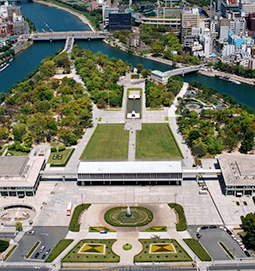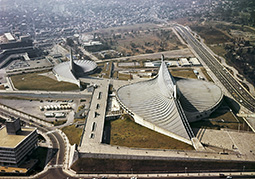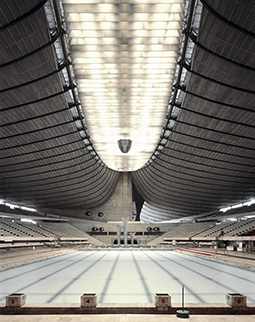Home > Highlighting JAPAN > Highlighting Japan November 2017 > Architects of Japan: Building the Future
Highlighting JAPAN

Kenzo Tange: The Legacy of an Architectural Legend
Works and the spirit left by a Japanese architect who fascinated the world with his unique style of architecture and city design continue to shine today.
Asked to identify Japanese architecture that influenced them, architects around the world often mention the National Gymnasium (now the Yoyogi National Gymnasium), which was designed by Kenzo Tange (1913–2005) and was used as one of the main venues of the Tokyo Olympic Games in 1964. Here Tange designed modern structures that expressed traditional Japanese beauty: the first gymnasium, an epoch-making structure in which the roof is suspended across two pillars; and the second gymnasium, for which one pillar was used. The buildings were designed to be the axis of the city (see here).
The Palace of the Soviets designed by Le Corbusier triggered Tange’s interest in architecture. He saw the work introduced in an art magazine when he was a student at Hiroshima High School. Astounded by the work, Tange enrolled in the Department of Architecture at Tokyo Imperial University (now the University of Tokyo) and apprenticed himself to Kunio Maekawa (1905–1986), who had studied directly under Le Corbusier, after graduating from the university.
It was the Hiroshima Peace Center (now the Hiroshima Peace Memorial Museum and Hiroshima Peace Memorial Park), which constituted the foundation for the restoration plan for Hiroshima after the atomic bombing, that made Tange a world-famous architect. The design was bold in that it lifted a structure 82.3 meters wide with twenty concrete pillars standing 6.5 meters high. The building highlights the beauty of pillars stretching vertically, like the Katsura Imperial Villa, and the delicate sense of traditional architecture.
Tange’s importance can be seen in other areas as well. Tange designed Hiroshima Peace Memorial Park with a focus on city planning. Ahead of the Hiroshima Peace Memorial Museum, which plays a role as a gateway from the main road, Tange intentionally left the Old Hiroshima Prefectural Industrial Promotion Hall (Atomic Bomb Dome) that was exposed to radiation and whose framing had been exposed, and gave Hiroshima a nature as a city that prays for peace as well as for restoration from the disasters of war by introducing the Atomic Bomb Dome as a symbol.
Noritaka Tange, the current chairman of Tange Associates, which carries on the Tange legacy, says, “My father was probably one of the first architects who closely connected architecture and cities interactively in the world. My father’s thoughts on design included the themes of cities and architecture, and traditions and creation. Today, of course, social requests for architecture are significantly different from the era when my father was active, but these two themes still remain as the basic concepts behind all our designs today.”
After the devastation in Hiroshima, Tange worked on city design by integrating local traditions with modern architecture in Asia and Europe as well. For example, in the Fiera district of Bologna, Italy, where the plan commenced in 1975 and was completed in 1987, Tange provided a modern reinterpretation of the elements of Bologna’s medieval streetscape of porticos1, towers and piazzas. Tange’s style is still rated highly.
In 1961, Tange released a “Plan for Tokyo 1960” for remodeling the city structure of Tokyo. In anticipation of the continuous development of Tokyo, Tange envisaged an offshore city stretching between Tokyo and Chiba across Tokyo Bay. This plan did not materialize, but unexpectedly, the Tokyo 2020 Olympic and Paralympic Games will be held in a location that Tange designed as the starting point on the edge of Tokyo in his plan for Tokyo.
For the 2020 Tokyo Olympics, Tange Associates is again involved in the design of sports facitilies. Chairman Noritaka Tange says, “Yoyogi National Gymnasium was designed in a way that enabled spectators and athletes to unite as one. We will make proposals for creating a sense of unity, even outside the gymnasium, enabling people to enjoy the unique mood of Tokyo.” He adds, “We need to use the Olympic Games as an opportunity to reconstruct Tokyo as a better city. The Tokyo 2020 Olympic and Paralympic Games will show the way the Olympics should be held in a mature city in the future.”
More than half a century has passed since 1964, and Tokyo now has another opportunity to make new proposals for the relationships between people, architecture and cities both inside and outside the country.
Note
1 A portico is a roof supported by columns that serves as a building’s street-facing porch.
© 2009 Cabinet Office, Government of Japan










